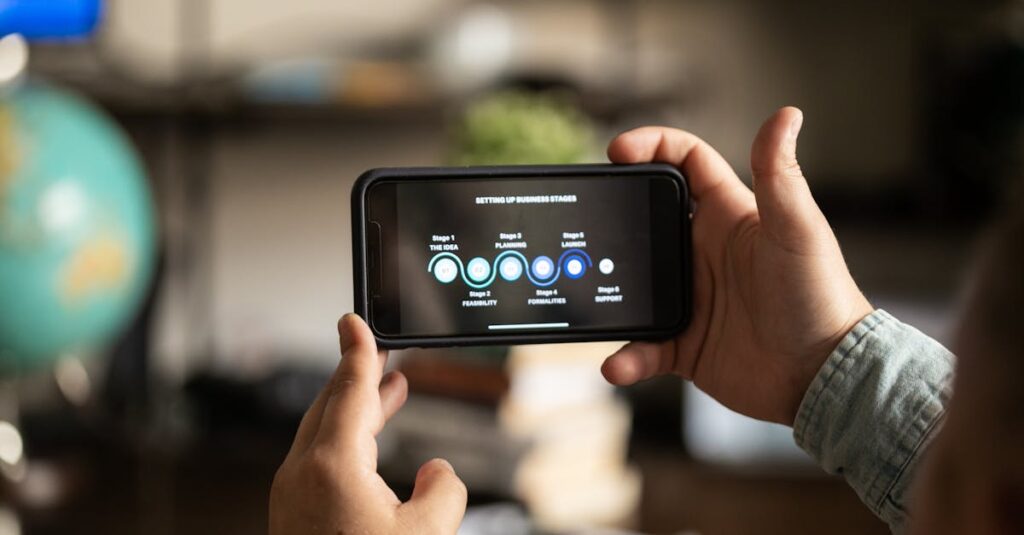Table of Contents
ToggleIn a world where everyone seems glued to their smartphones, creating a mobile app that stands out is no small feat. With millions of apps vying for attention, developers must navigate a minefield of best practices to avoid the dreaded “delete” button. But fear not, because mastering mobile app development isn’t just about avoiding pitfalls; it’s about crafting an experience that users will love.
Understanding Mobile App Development Best Practices
Focusing on user experience improves engagement. Integrating seamless navigation keeps users exploring the app. Implementing responsive design ensures compatibility across various devices and screen sizes. Employing intuitive interfaces helps users easily understand how to use the app.
Testing throughout the development process catches bugs early. Conducting thorough user testing reveals insights into actual user behavior and preferences. Using analytics provides valuable data to track user interactions and identify improvement areas.
Offering regular updates enhances user retention. Communicating clear release notes informs users of changes and new features. Complying with platform guidelines increases app visibility in app stores.
Securing user data builds trust. Utilizing encryption methods protects sensitive information from unauthorized access. Providing clear privacy policies explains how user data is handled.
Optimizing performance is essential for a smooth user experience. Minimizing load times reduces frustration and keeps users engaged. Using efficient coding practices ensures the app runs smoothly on varying hardware capabilities.
Lastly, prioritizing accessibility expands the user base. Implementing features for users with disabilities creates a more inclusive experience. Following accessibility guidelines guarantees the app caters to diverse needs.
Key Principles of Mobile App Development
Focusing on key principles enhances the quality of mobile app development. These principles guide developers in creating effective and user-friendly applications.
User-Centered Design
User experience remains vital in mobile app development. Engaging users requires prioritizing their needs. Developers should conduct user research to understand preferences, pain points, and behaviors. Creating user personas aids in designing targeted solutions. Intuitive navigation simplifies interaction, leading to happier users. Feedback mechanisms should allow users to share their experiences, fostering continuous improvements. Designing for accessibility ensures inclusivity, catering to diverse user abilities. Keeping designs simple and aesthetically pleasing encourages exploration and retention. Ultimately, a user-centered approach greatly boosts satisfaction and loyalty.
Performance Optimization
Performance optimization plays a crucial role in user retention. Fast load times lead to positive user experiences. Developers should minimize image sizes and leverage efficient coding techniques to improve performance. Regular testing identifies bottlenecks and enhances responsiveness. Employing caching strategies reduces data fetching times, making apps feel snappier. Additionally, optimizing battery consumption keeps users engaged longer without draining their devices. Adhering to platform-specific guidelines provides optimal performance tailored to each operating system. Constantly monitoring app performance enables developers to implement necessary improvements swiftly. Prioritizing these strategies ensures smooth and enjoyable app interactions.
Development Methodologies
Effective development methodologies play a crucial role in mobile app success. Selecting the right approach can streamline processes and enhance final outcomes.
Agile Development
Agile development emphasizes flexibility and iterative progress. Teams work in short cycles, known as sprints, to deliver incremental improvements. User feedback influences each sprint, enabling quick adjustments and enhancement of user experience. Collaboration among cross-functional teams fosters innovation and ensures that everyone contributes vital skills. Responsiveness to change allows developers to address evolving market demands promptly, enhancing the app’s relevance and usability. Frequent testing throughout each cycle helps catch issues early and refine features based on user insights.
Waterfall Approach
Waterfall approach follows a linear and sequential development process. Each phase, from requirement gathering to deployment, occurs one after the other, providing a structured framework. Clarity in requirements upfront significantly reduces misunderstandings. Deliverables at each stage must meet predefined criteria before proceeding to the next phase. However, this methodology lacks flexibility, making it less adaptable to changes in project scope or user needs. Testing occurs only after completion, which can lead to late discovery of critical issues. Despite its limitations, some prefer this method for projects with well-defined requirements and timelines.
Testing and Quality Assurance
Testing and quality assurance play vital roles in mobile app development, ensuring functionality and user satisfaction. Efficient testing practices help identify issues early, preventing costly fixes later in the process.
Automated Testing
Automated testing streamlines the verification of app functionality by utilizing scripts and tools. Developers use this method to repeatedly test code changes, enhancing reliability. Adopting automated tests facilitates quick feedback during development cycles. Integration with continuous integration systems saves time and allows for consistent quality checks. Testing frameworks such as Appium or XCTest simplify this process, supporting both Android and iOS applications. Frequent execution of automated tests reduces regression bugs and increases overall efficiency. Developers can focus more on complex problem-solving when routine tasks are automated.
User Acceptance Testing
User acceptance testing (UAT) ensures the finished product meets user expectations. Engaging real users during this phase provides valuable insights and feedback. Teams can better understand user needs and identify any overlooked issues. Conducting UAT involves representative end-users testing the app in realistic scenarios. Gathering direct feedback highlights usability improvements and feature requests. Incorporating this feedback before launch increases the likelihood of user satisfaction. Regular UAT sessions throughout development help teams stay aligned with user preferences and expectations. By prioritizing user feedback, developers foster stronger relationships and improve app adoption rates.
Deployment and Maintenance
Deployment and maintenance are crucial stages in mobile app development that directly impact user experience and engagement.
App Store Guidelines
App store guidelines dictate the standards and practices developers must follow to publish their applications successfully. Understanding these requirements ensures compliance, which enhances visibility and discoverability in app stores. Each platform, like Apple’s App Store or Google Play, has specific rules regarding user privacy, app functionality, and design standards. Meet these criteria to avoid rejection during the review process. Testing the app against platform guidelines before submission reduces the likelihood of delays and helps streamline the launch. Regularly reviewing updates to these guidelines keeps developers informed and helps maintain compliance over time.
Regular Updates
Regular updates significantly improve app performance and user satisfaction. New features, bug fixes, and performance enhancements keep users engaged and address issues promptly. Many users appreciate clear communication regarding updates, including release notes that outline changes and improvements. Listening to user feedback can guide update priorities, ensuring that development teams address the most critical issues first. Schedule updates consistently to establish trust and demonstrate commitment to quality. Monitoring app performance post-launch also reveals areas for improvement, making it easier to implement necessary changes swiftly. Regular maintenance not only extends the app’s lifecycle but also fosters user loyalty.
Mobile app development demands a strategic approach to stand out in a competitive landscape. By prioritizing user experience and implementing best practices, developers can create apps that not only attract users but also retain them. Regular testing and updates play a vital role in maintaining app performance and user satisfaction.
Adopting methodologies like Agile can enhance flexibility and responsiveness to user feedback. Ultimately, focusing on accessibility and security fosters trust and engagement among users. A commitment to continuous improvement ensures that the app remains relevant and enjoyable, paving the way for long-term success in the mobile app market.





